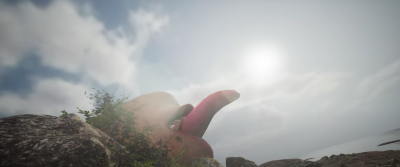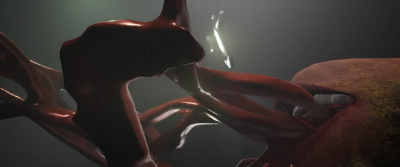Driftnote is the 3D animator behind the visuals in Tanya Tagaq’s most recent music video. (Photo by Francesca Chudnoff)
Meet the Afro-Indigenous animator behind Tanya Tagaq’s new video
Omar Rivero used satellite data from Cambridge Bay to model the landscape in ‘Tongues’ video
Accompanying Inuk artist Tanya Tagaq’s new song Tongues — released days before the first National Day for Truth and Reconciliation last week — is a powerful video done in 3D animation.
Omar Rivero, who produces art under the name Driftnote, is behind the symbolic visuals, like a tongue embedded in the tundra, which represents Inuit languages.
Rivero, who now resides in Toronto, is Afro-Indigenous and grew up in Venezuela.
The artist — who uses the pronoun “they” — learned 3D animation about six years ago to add visuals to their own music and for live events, but the COVID-19 pandemic has driven Rivero towards more music video work, like Tagaq’s.
Despite being from opposite ends of North and South America, Rivero said they and Tagaq’s ancestors have lived similar experiences of colonialism, resulting in a shared understanding between the two artists.
“For folks who are also trying to do work related to their culture, I think it would be great to acknowledge we’re not alone,” Rivero said.
“Your family extends beyond North America and a lot of us are here to preserve what our ancestors have fought so hard for.”
Rivero spoke with Nunatsiaq News about the two-month process of making the video and how satellite data of Nunavut’s geography was used to create the landscape.

The lower face and tongue in the music video is based on Tanya Tagaq’s face. (Screenshot courtesy of YouTube/Tanya Tagaq)
Nunatsiaq News: What was the process of creating the video?
Rivero: Tanya’s team had a rough idea of what they wanted the storyline of the video to be and they knew they wanted to have the tongue coming out of the mouth in the ground. It was a lot of planning before I started the actual [animation] work. In this case, we had a lot of reference photos for the landscape, so we talked about what the ground should look like, what season it should be, and on my own time, I researched things like the foliage and plants in the region to get a sense of what the landscape looks like. I received some photos directly from Tanya she took on her phone [in Cambridge Bay], like things she’d find on the ground like bones and lichen and moss. Then, I began to construct the surface of the land. My idea for that was to use satellite data, very similar to what you see on Google Maps, but this data gives me height information — like a 3D scan of the ground. I decided to take data from where Tanya currently resided, in Cambridge Bay. The 3D model of the mouth comes from an avatar that Tanya had already. Someone had made an avatar [based on Tanya] and I took the chin area and decorated it with rocks and put it in the ground.
NN: Can you walk me through some of the symbolism in the video and the meaning behind some of those powerful visuals?
Rivero: We knew we wanted to play with the literal tongue representing the language, which allowed us to show the tongue having a conflict with a Catholic cross. I wanted to have these very contrasting materials, where the tongue is a very fleshy softer material that has to come in contact with this very sharp, hard-edged metallic material. You see [this] later on in the video when the tongue encounters the cross and the tongue splits. But, it’s an unsuccessful attack on the part of the Catholic Church. The tongue comes back together to restore and regenerate itself.

The tongue in the music video symbolizes language, and the cross severing it represents the church’s role in suppressing the use of the Inuit language. (Screenshot courtesy of YouTube/Tanya Tagaq)
NN: What was it like to be part of such a powerful project that was released right around the first day for truth and reconciliation?
Rivero: Being Indigenous myself, when Tanya’s talking about preserving your culture and your native tongue [in the song], that relates to me personally, as I have fragments of my own native tongue. It felt like such a significant collaboration. We have both experienced colonization from two different places in the Americas. We have a kind of kinship and understanding of the struggle our ancestors had to overcome. I feel like our collaboration is sort of a testament to how we have been able to survive the atrocities and have a dedication to preserve our cultures and our connection to the land.






ever wonder why Tanya Gillis doesn’t ‘perform’ up north?
because little to nobody would see a free show let alone pay for this stuff she pans to southern folk.
Artist s , where would we be without them !
Or, to rephrase your implied critique a bit, ; she has an appreciative international audience open to more complex and challenging forms of music than those you apparently enjoy. There’s nothing wrong with the borrowed hip-hop beats and recycled pop that so many artists rely on; however, she’s chosen to do something a bit more original.
I think that a lot of people who are put off by Tanya are less put off by her music, even if they don’t care for or understand it, but by what they perceive to be her aggressive, bullying antics against other artists or people she is opposed to for whatever reason.
I’m aware of her comments on appropriation of musical forms, some of which I agree with, some of which I don’t. That really doesn’t matter; I doubt there’s a single musician, composer, writer, painter, sculptor or artist in medium whose political and social views I agree with 100%. That’s irrelevant to the appreciation and enjoyment of their work.
Of course, I think my point was meant to be descriptive and not normative.
So, I am not saying an appreciation of artistry should be contingent on mutually shared political views. However, when you say political views are irrelevant to an appreciation of artistry, you seem to be hinting at a normative claim.
Yet a strong divergence of perspectives can and often does affect how we perceive public figures, artists included (compartmentalization is not always easy, or perhaps natural to us).
What I was getting at is my sense that much, or at least some, of the antipathy we see toward Tanya in these comments is probably more closely related to people’s distaste for her politics than for her music itself.
It’s true that many of us know this… still, I felt it should be added to the discussion.
Fantastic job on the visuals to accompany this powerful song.
Good luck to singers and performers in all of Nunavut, and every where else !
Why do people have to bring colonization into the equation all the time !
All the peoples of the Planet earth have been colonizer at one time or another, regardless
of race. It is what we have been doing for many, many, thousands of years.
She rocks. All you people that get so upset about her music would rather listen to the polka music played with accordion and fiddle on local radio. I can’t STAND listening to that stuff.